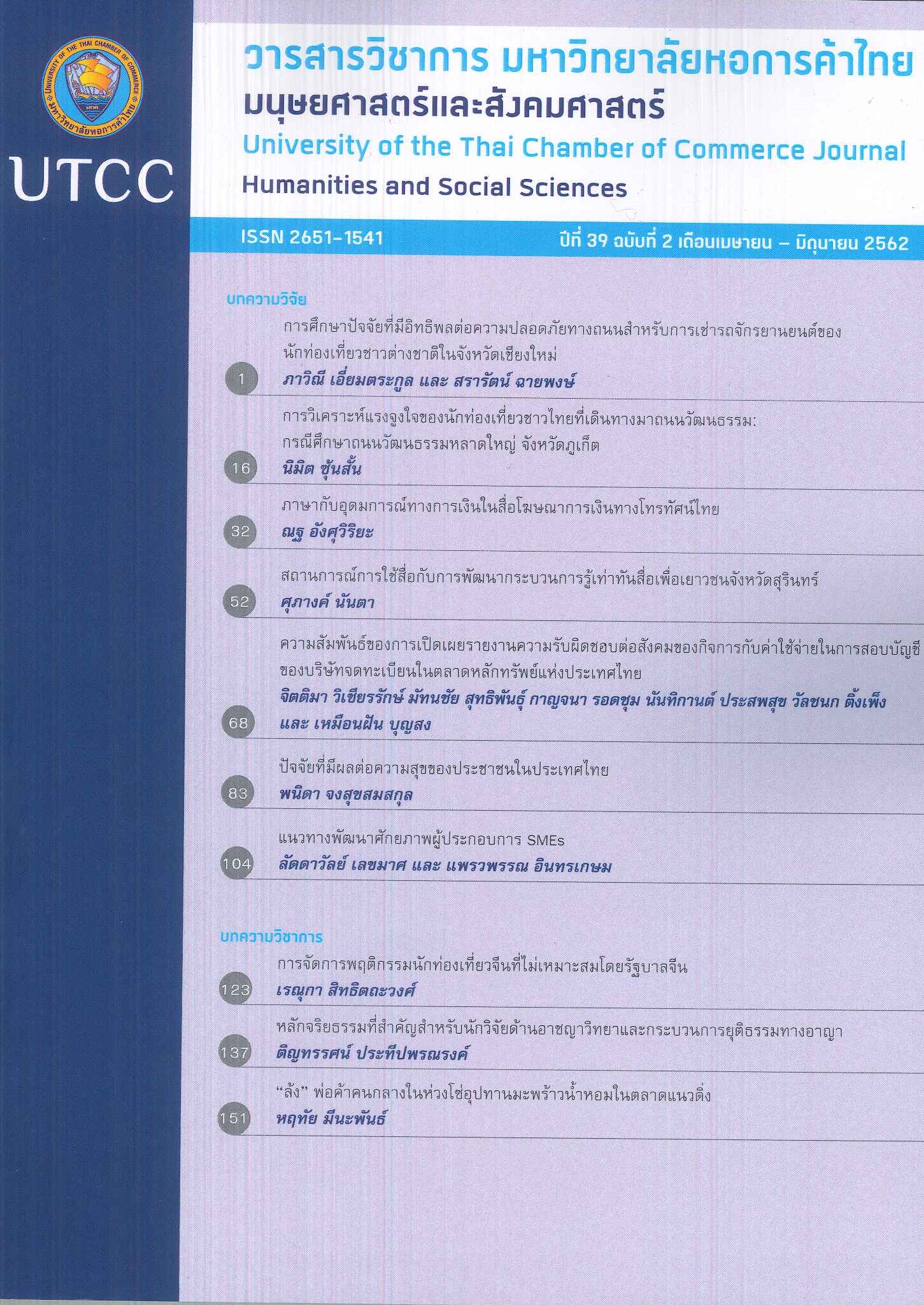Factors Affecting Happiness of the People in Thailand
Main Article Content
Abstract
The present study of factors affecting the happiness of the people in the Northern and Central Parts of Thailand were selected using a cluster sampling technique. The aims of the study are the analysis of factors affecting the happiness of people in these areas. Communication is an important dimension although mental and physical health, economic security, job security, administrative management, family relationships and the environment are also dimensions under consideration. In-depth interviews of 6 key informants were carried out for appropriate questionnaire design. Then collected data by using the quantitative technique with 387 people (α=0.05), found the levels of happiness of people are in the middle-average range ( = 6.3). The study explores indicators for communication as factors affecting happiness, especially, face – to – face communication and participatory communication between government to promote Thai people’s health, policy agenda and provide a budget for living sustainability and maintaining a sustainable lifestyle. Moreover, living with transparency and participatory communication led to diverse rewards in many areas.
Article Details
ลิขสิทธิ์ของบทความ
ผลงานที่ได้รับการตีพิมพ์ถือเป็นลิขสิทธิ์ของมหาวิทยาลัยหอการค้าไทย ห้ามมิให้นำเนื้อหา ทัศนะ หรือข้อคิดเห็นใด ๆ ของผลงานไปทำซ้ำ ดัดแปลง หรือเผยแพร่ ไม่ว่าทั้งหมดหรือบางส่วนโดยไม่ได้รับอนุญาตเป็นลายลักษณ์อักษรจากมหาวิทยาลัยหอการค้าไทยก่อน
References
นวลฉวี ประเสริฐกุล. (2558). สื่อสารอย่างสร้างสรรค์เพื่อสร้างสุขในครอบครัว. Veridian E-Journal. ฉบับภาษาไทย สาขามนุษยศาสตร์ สังคมศาสตร์ และศิลปะ, 8(2), 737-747. สืบค้นจาก
https://www.tci-thaijo.org/index.php/Veridian-E-Journal/article/download/38603/31946
พนิดา จงสุขสมสกุล. (2559). ความสุขของคนดอนแก้ว อำเภอแม่ริม จังหวัดเชียงใหม่. วารสารสถาบันพระปกเกล้า, 14(2), 87-104.
สำนักงานคณะกรรมการพัฒนาการเศรษฐกิจและสังคมแห่งชาติ. (2560). ร่างยุทธศาสตร์การพัฒนาเศรษฐกิจและสังคมแห่งชาติ 20 ปี พ.ศ. 2560-2579. สืบค้นเมื่อ 3 กรกฎาคม 2559, จาก https://www.nesdb.go.th/download/ document/SAC/NS_Draftplan-Aug2017.pdf
สำนักงานสถิติแห่งชาติ. (2558). สรุปผลที่สำคัญ การสำรวจสุขภาพจิต (ความสุข) คนไทย สิงหาคม พ.ศ. 2558. สืบค้นเมื่อ 3 กรกฎาคม 2559, จาก https://service.nso.go.th/nso/nsopublish/themes/files/mental-healthm_aug_58.pdf
โสรัจจ์ หงศ์ลดารมภ์. (2545). วิทยาศาสตร์ในสังคมและวัฒนธรรมไทย. กรุงเทพฯ: สำนักงานกองทุนสนับสนุนการวิจัย.
วิทมา ธรรมเจริญ, นิทัศนีย์ เจริญงาม, และนิตยา ชนะสิทธิ์. (2561). ความอยู่ดีมีสุขของผู้สูงอายุ: กรณีศึกษาตำบลสองพี่น้อง อำเภอท่าใหม่ จังหวัดจันทบุรี. วารสารวิชาการ มหาวิทยาลัย
หอการค้าไทย มนุษยศาสตร์และสังคมศาสตร์, 38(1), 36-53.
สำนักงานคณะกรรมการการกระจายอำนาจให้แก่องค์กรปกครองส่วนท้องถิ่น. (ม.ป.ป.). องค์กรปกครองส่วนท้องถิ่นที่มีการบริหารจัดการที่ดี ปี พ.ศ. 2558. สืบค้นเมื่อ 3 กรกฎาคม 2559, จาก https://www.odloc.go.th/web/?page_id=3315
อภิสิทธิ์ ธำรงวรางกูล. (2543). โครงการวิจัยกระบวนการพัฒนาตัวชี้วัดความสุขของประชาชนชาวไทย: รายงานวิจัยฉบับสมบูรณ์. กรุงเทพฯ: สำนักงานกองทุนสนับสนุนการวิจัย.
Bradburn, N. M., & Caplovitz, D. (1965). Report on happiness. Chicago, IL: Aldine.
Carey, J. W. (2009). Communication as culture: Essays on media and society (Rev. ed.). Oxfordshire, England: Taylor & Francis.
Jongsuksomsakul, P. (2016). Media and happiness of NongKwaw Indigenous People, Thamuang District Kanchanaburi Province. Media Asia, 42(3), 166-179.
Layard, R. (2005). Happiness: Lessons from a new science. New York: Penguin Press.
O'Keeffe, G. S., Clarke-Pearson, K., & Council on Communications and Media. (2011). The impact of social media on children, adolescents, and families. American Academy of Pediatrics, 127(4), 800-804. Retrieved from https://pediatrics.aappublications.org/content/pediatrics/early/ 2011/03/28/peds.2011-0054.full.pdf
Sen, A. K. (1999). Development as freedom. Oxford, England: Oxford University Press.
Watzlawick, P., Bavekas, J. B., & Jackson D. D. (2011). Pragmatics of human communication: A study of interactional patterns, pathologies and paradoxes. New York: Norton.
Yamane, T. (1973). Statistics: An introductory analysis (3rd ed.). New York: Harper and Row.


